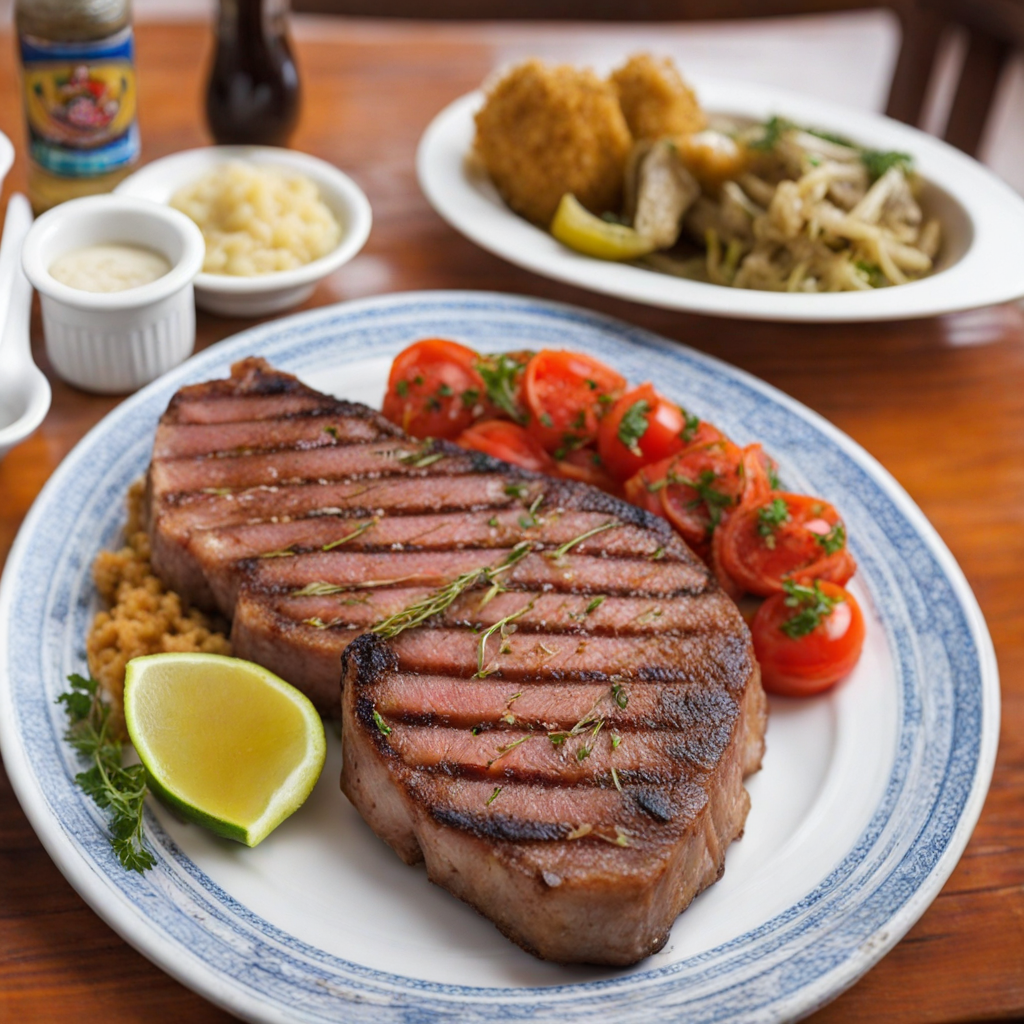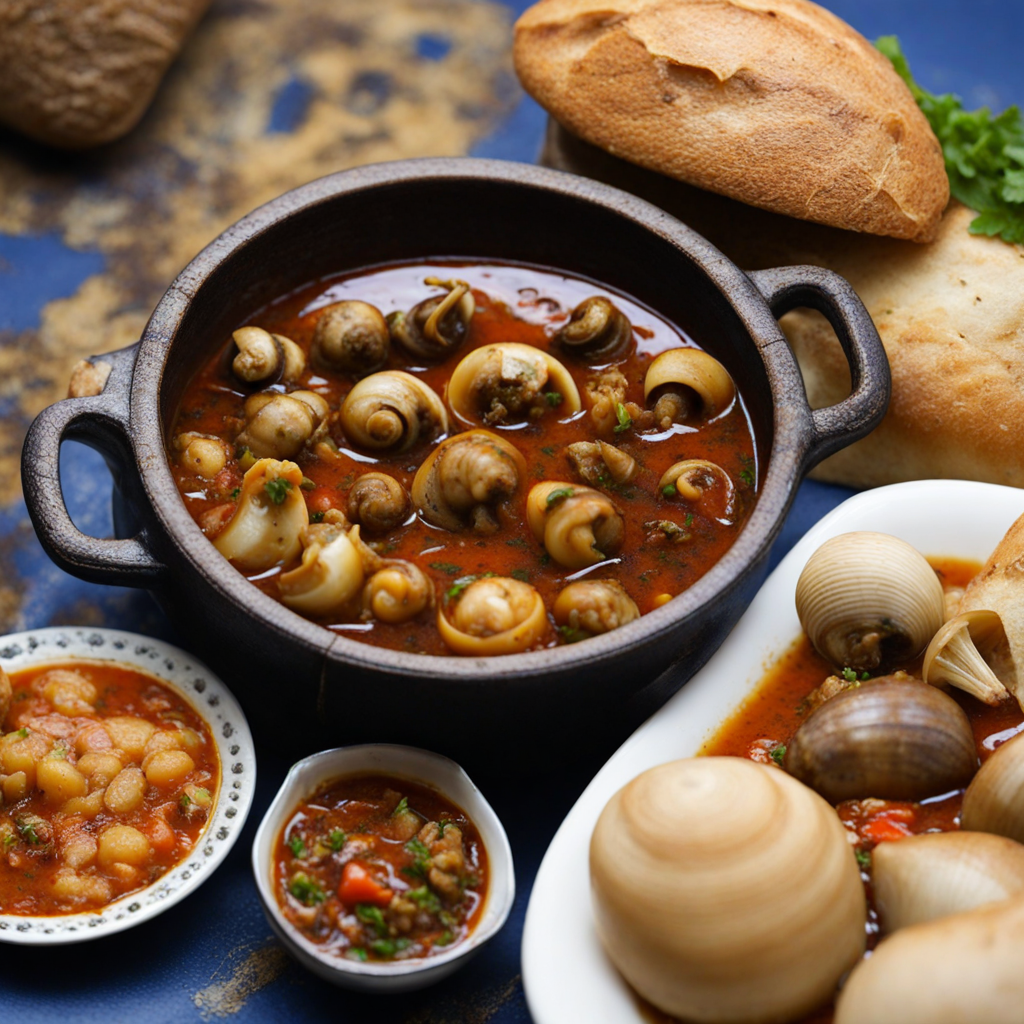Lagostada
Lagostada is a delightful dish from Cape Verde that showcases the country's rich culinary heritage, blending flavors and textures to create a memorable dining experience. At its core, Lagostada features fresh lobster, a prized ingredient in Cape Verdean cuisine, known for its tender meat and subtle sweetness. The lobster is typically grilled or sautéed, allowing its natural flavors to shine through while being complemented by a variety of spices and herbs that reflect the vibrant flavors of the islands. The seafood is often served atop a bed of crispy fried dough, reminiscent of a pizza base, adding a unique crunch that contrasts beautifully with the succulent lobster. The accompanying sauce is where Lagostada truly comes to life, often made from a blend of tomatoes, garlic, onions, and a hint of chili, providing a deliciously tangy and slightly spicy kick. This sauce is generously poured over the lobster and dough, infusing the dish with rich, savory flavors that marry together wonderfully. Additionally, local ingredients such as fresh lime, cilantro, and perhaps a sprinkle of local cheese can be added, elevating the overall taste profile and making each bite an explosion of flavor. As you savor Lagostada, you’ll find that it embodies the essence of Cape Verdean culture—simple yet profound, with an emphasis on fresh, high-quality ingredients. The dish is often enjoyed with a side of rice or a fresh salad, making it a well-rounded meal that is perfect for sharing with loved ones. With each bite, you’re not just tasting a dish, but also experiencing a piece of Cape Verde’s vibrant culinary tradition that celebrates the bounty of the ocean and the warmth of its people.
How It Became This Dish
The Culinary Journey of Lagostada: A Cape Verdean Delight Origins and Historical Context Lagostada is a traditional dish from Cape Verde, an archipelago located off the northwest coast of Africa. This vibrant collection of islands, known for its stunning landscapes and rich cultural heritage, has a unique culinary scene shaped by its geography, history, and the blending of various cultural influences. The origins of Lagostada can be traced back to the early colonial period when Portuguese explorers settled in the islands in the 15th century. The islands' isolation meant that the local population had to rely on the ingredients available to them, leading to a rich tapestry of flavors and cooking techniques. Lagostada is a dish that showcases this blend of local and colonial culinary practices. The name itself suggests a connection to the Portuguese word "lagosta," meaning lobster, which is a key ingredient in this dish. The dish typically features a base of rice or a similar grain, seasoned with spices, vegetables, and, of course, lobster, creating a hearty and flavorful meal that reflects the oceanic bounty of the islands. Cultural Significance Lagostada is more than just a culinary delight; it is a symbol of Cape Verdean identity and resilience. The dish is often prepared during family gatherings, festive occasions, and communal celebrations, embodying the spirit of togetherness that is central to Cape Verdean culture. Its preparation is a communal activity, where family members come together to cook, share stories, and enjoy each other's company. This communal aspect of cooking fosters a sense of belonging and continuity, linking generations through shared traditions. In Cape Verde, the significance of Lagostada extends beyond the dining table; it is intertwined with the islands' history, particularly the influence of the sea on the local way of life. Fishing has been a vital part of Cape Verdean culture for centuries, and dishes like Lagostada highlight the importance of marine resources. The dish is often associated with the fishing communities of the islands, where lobster and other seafood are abundant. As a result, Lagostada serves as a reminder of the islands' connection to the ocean and the livelihoods that have depended on it. Ingredients and Preparation The preparation of Lagostada showcases a variety of ingredients that are both locally sourced and reflective of Cape Verde's colonial past. The dish typically includes: - Lobster: Freshly caught, lobster is the star of Lagostada. The availability of lobster varies by season, and its preparation can differ based on local customs and family recipes. - Rice or Cornmeal: The base of the dish is usually rice, though in some variations, cornmeal or other grains might be used. The choice of grain often depends on regional preferences and availability. - Tomatoes and Onions: These vegetables add depth to the dish, enhancing its flavor profile. They are often sautéed with garlic and spices to form a rich base. - Spices: The use of spices is crucial, with ingredients like paprika, bay leaves, and black pepper being common. These spices reflect the influence of both African and Portuguese cooking traditions. - Vegetables: Depending on the season, a variety of vegetables such as bell peppers, carrots, and peas may be added, contributing color and nutritional value to the dish. The preparation of Lagostada is methodical, often starting with the sautéing of onions and garlic, followed by the addition of tomatoes and spices. The lobster is then cooked with the rice or grain, allowing the flavors to meld together beautifully. The result is a fragrant, colorful dish that is as visually appealing as it is delicious. Evolution and Modern Variations Over the years, Lagostada has evolved, adapting to modern culinary trends while still honoring traditional recipes. As Cape Verde has become more integrated into the global culinary landscape, chefs and home cooks alike have explored new ways to prepare and serve Lagostada. This evolution reflects a broader trend in Cape Verdean cuisine, where traditional dishes are increasingly being reimagined and presented in innovative ways. One notable development is the incorporation of international flavors and techniques. While traditional Lagostada is rooted in local ingredients and methods, contemporary interpretations may include influences from other cuisines, such as Italian or Asian. For example, some chefs experiment with different types of seafood, such as shrimp or fish, while others may introduce unique sauces or garnishes that enhance the dish's presentation and flavor. Additionally, with the rise of tourism in Cape Verde, Lagostada has gained popularity among visitors looking to experience authentic Cape Verdean cuisine. This exposure has led to a greater appreciation for the dish, with restaurants and local eateries featuring Lagostada on their menus. As a result, the dish has become an ambassador of Cape Verdean culinary heritage, bridging the gap between tradition and modernity. Conclusion Lagostada is a dish that embodies the rich history and cultural significance of Cape Verde. Its origins reflect the islands' colonial past and the resilience of its people, while its preparation and communal nature highlight the importance of family and togetherness in Cape Verdean culture. As it continues to evolve, Lagostada remains a beloved culinary staple, celebrating the islands' unique flavors and traditions. In a world where culinary boundaries are increasingly blurred, Lagostada serves as a reminder of the importance of preserving cultural heritage while embracing innovation. It is a delicious representation of Cape Verde’s identity, connecting past and present, and inviting people to share in the warmth and hospitality that the islands are known for. Whether enjoyed at a family gathering, a festive celebration, or in a restaurant by the sea, Lagostada remains a cherished dish that tells the story of Cape Verde and its people.
You may like
Discover local flavors from Cape Verde







